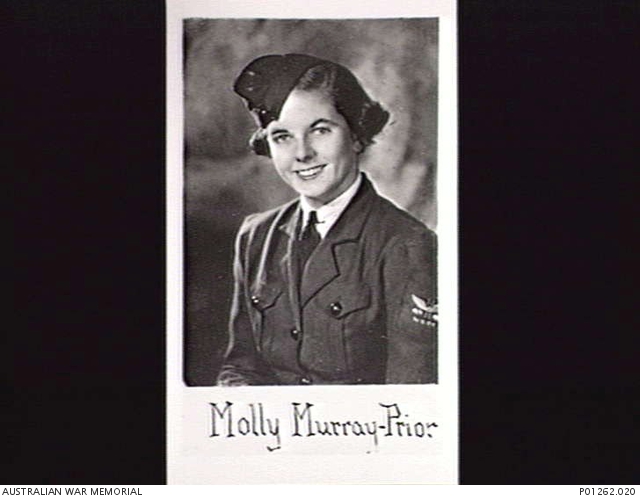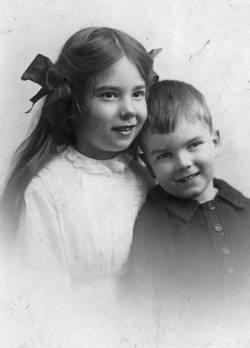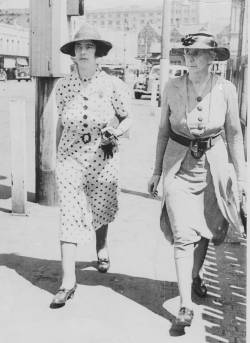Robert and Estella M-P
Children
1. Nora Estella (19091) - 19842)). Like her sisters, she went to school at SCEGGS.
She was active in youth groups including the Crusaders and the Brownies, the latter as a member and, when adult, leader. She trained as a nurse at Royal North Shore Hospital during 1936-37, reputedly too late to be accepted in general nurse training, but able to train as a children's nurse. She then worked at the War Memorial Hospital in Casino from September 1938 to March 1940. By 1944, she was a nursing Sister with the Royal Far West Society, with her headquarters at Inverell.3) The work involved much travelling around the local area for more, click on **nursing with Royal Far West**.
The next three photos are of Nora4): the 1st with her elder brother E. Sterling M-P; the 2nd probably on the day she qualified as a nurse; the 3rd with her mother (right):
Nora left the Royal Far West Children's Scheme early in 1949 to marry5) widower Lawrence Ashley Frederick Boyd (known as Ashley). Nora was step-mother of Ashley's two daughters, but there were no children born of their marriage. He had a sheep/wheat property, Eldorado, near Young, NSW. My recollection of her is someone who could be very kind but also very tactless, while her extensive travelling in later life did not change her narrow view of the world.
2. Edgar Sterling (16 May 1911 - — 20106))
He never forgave his parents for their choice of his given names, but chose to be known Sterling as the lesser of two evils. He attended Sydney Grammar until he was around 15, when his father found him work at the Perpetual Trustee Company. He was later to deprecate his schooling as being so hidebound with its stress on unthinking obedience (such as the poems The Charge of the Light Brigade and Casabianca_(poem)). He was, however, good at mathematics with a prize to show for it in 1924 when he was 13 years old. That talent would stand him in good stead not only in his work, but as honorary treasurer of the Bellingen RSL Club in his later life.7) He was a keen sportsman, a member of the Mona Vale Surf Life saving Club and a good amateur boxer. A photo in the Ryde Library of the 1932 Hunters Hill Rugby team describes him (middle row, second from left) as its Honorary secretary. To see click rugby.
He married Brenda Isabel Pottie (15 July 1914-18 July 20088) at St Stephen's Presbyterian Church on 29 November 1938. Brenda (known also as Isabel and Isa) had grown up at Waverley, attending the once-progressive school Shirley then, for her final year/s, SCEGGS. Before her marriage, she lived with her mother at 6 Viret Street, Hunters Hill. Brenda's father Herbert (Bert), a vet, had died when she was a toddler. He left his widow Ethel (known by her second name, Brenda) with five young children (Brenda and her four older brothers). Bert's father John Pottie had established the veterinary practice and published two books on the care of horses, then the mainstay of veterinary practices.9) Bert's mother Eliza Pottie was a Quaker, temperance advocate and highly active philanthropist who took a leading role in the fight for women's suffrage.10) Brenda's mother found it difficult to adjust to the financial implications of her husband's death, and continued with much the same style of living. After the younger Brenda left school, she became a highly skilled typist in the NSW Tax Office [check].
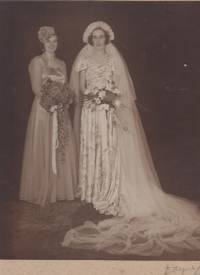 Photo: Brenda M-P on her wedding day with her bridesmaid and sister-in-law Molly M-P.11)
Photo: Brenda M-P on her wedding day with her bridesmaid and sister-in-law Molly M-P.11)
Sterling and Brenda's only son was born 10 months after they married (luckily at this censorious time, he was not premature like their next child!). A month after his birth, World War II started. Sterling enlisted on 11 July 194012) and served as a Gunner13) in the 2/9 Field Regiment.14) He served in the Middle East for over a year, as well as in South Australia and North Queensland. As far as is known, he did not see his wife or son again until 1945.
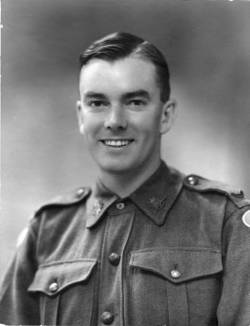 ES M-P shortly after he enlisted, c.1940 15)
ES M-P shortly after he enlisted, c.1940 15)
Sterling had thrived amidst mates from very different backgrounds and in highly physical work, and returned a very different man. With the war's end, he was discharged from the army on 6 November 1945.16) He was re-employed at Perpetual but found being confined to a desk job difficult. On the advice of his brother-in-law, he used almost all of his and his wife's money to buy a dairy farm from a relative of his brother-in-law's wife. The date of the purchase could later be seen as prophetic: 1 April 1949.17) The farm was at Hydes Creek, four miles from Bellingen. Sterling, Brenda, their son and daughter moved there; a second daughter was born nearly two years later. The farm was never a viable proposition, despite the efforts of agricultural researchers to find alternative crops, and became less so with the inexorable decline of the North Coast dairy industry. While he thrived on the outdoor life and went from total inexperience to a highly respected farmer, Sterling's big achievement was to wrest a minimal living from infertile land. He only once, in the late 1960s, accepted a desk job to tide the family over a specially bad drought. His wife and son had a particularly challenging time due to their huge decline in living conditions: Hydes Creek had no electricity until 1962; the roads were untarred; and when he entered High School their son had to undertake a long commute to Coffs Harbour High School, involving bike, bus and train. Dairy cows need to be milked twice a day and the family could not afford any help; in later years Sterling made a yearly trip to Sydney to see his widowed mother, but Brenda rarely had a day away from the farm. Even when bitten by a red-back spider, she had to drive herself to Bellingen Hospital while the rest of the family did the milking.
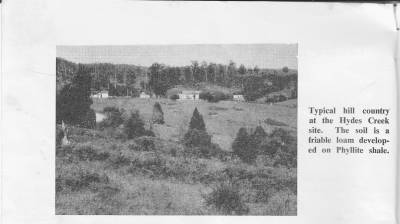 Photo of the M-P farm published in G. Wilson, F. Cradock, K. Flemons, 'Pasture and Soil Fertiity Investigations in the Bellingen District', The Agricultural Gazette, May 1961, p.244. The article reported one of the numerous crop trials at the farm. The farm now looks completely different - the house has been moved to a sub-division at the Bellingen end of the old property; the reedy creek has been dammed; and new buildings added. Returning to look at a site can be very misleading! (see google maps for 423 Hydes Creek Road.)
Photo of the M-P farm published in G. Wilson, F. Cradock, K. Flemons, 'Pasture and Soil Fertiity Investigations in the Bellingen District', The Agricultural Gazette, May 1961, p.244. The article reported one of the numerous crop trials at the farm. The farm now looks completely different - the house has been moved to a sub-division at the Bellingen end of the old property; the reedy creek has been dammed; and new buildings added. Returning to look at a site can be very misleading! (see google maps for 423 Hydes Creek Road.)
Brenda and Sterling benefited from family legacies as well as the local area being transformed by 'tree-changers' and the Australian Paper Manufacturers (APM, now Amcor). After they sold the farm, the local creek made into a dam, with the land apparently used as a hobby farm, the area looks idyllic and, to those who grew up there, unrecognisable. Brenda and Sterling enjoyed a comfortable retirement at 5 Hawea Close,Wamberal on the NSW Central Coast. Molly and John Wilson later moved to Wamberal in their retirement as well.
Sterling and Brenda M-P celebrating their 50th? wedding anniversary.18). 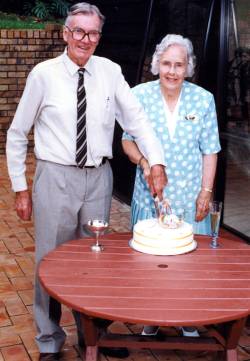
3. Phyllis Dorothea (1913 —) was born at home, at Cooroora in Hunters Hill.19) She was artistic, vivacious and, like so many of her era and her elder sister, retained the socially conservative views of her youth. She married grazier Alan Robert Cullen-Ward on 23 February 1935. He had a property 'Mani' at Cumnock, NSW as well as a house at Drummoyne in Sydney. They had two sons and three daughters including Susan who married (secondly) King Leka of the Albanians.
4. Evan David (191620)- March 1981). With his parents' help, he bought a farm at Wyong 21) and married Hilary Lorraine Piper (31 July 1916- 23 June 2014); the farm was sold after they divorced. They had two daughters. One daughter Beverley Joan (known as Joan) was [occupation?] and later in life struggled with deafness; she married — Black and lived in Tasmania. David and Hilary's other daughter became a highly respected midwife at King George V Hospital and, in retirement, an Anglican chaplain at St George Hospital. In later life, David shared a house with his mother at Hunters Hill until she died. In his final years he was reclusive; in contrast Hilary remained a 'people person'.
Three photos of David22): The latter two were taken at Brecondale, his (Herring) grandparents' home at Gladesville in Sydney. 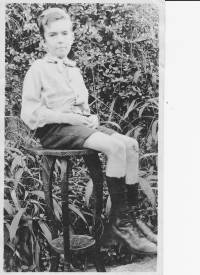
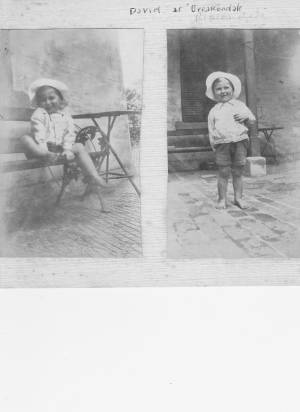
5. Sylvia Mary (Molly) (1919-200723)) joined the WRANs (Women's Royal Air Force) in 1942, during World War II. The following photo24) was taken c.1939 when she was a member of the Women's Emergency Signalling Corp, which trained signallers and telephonists.